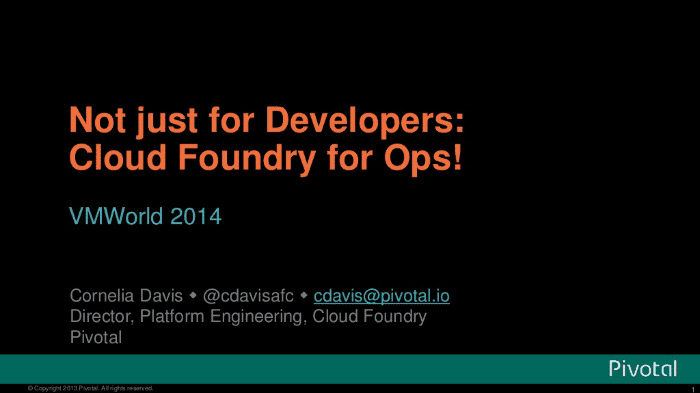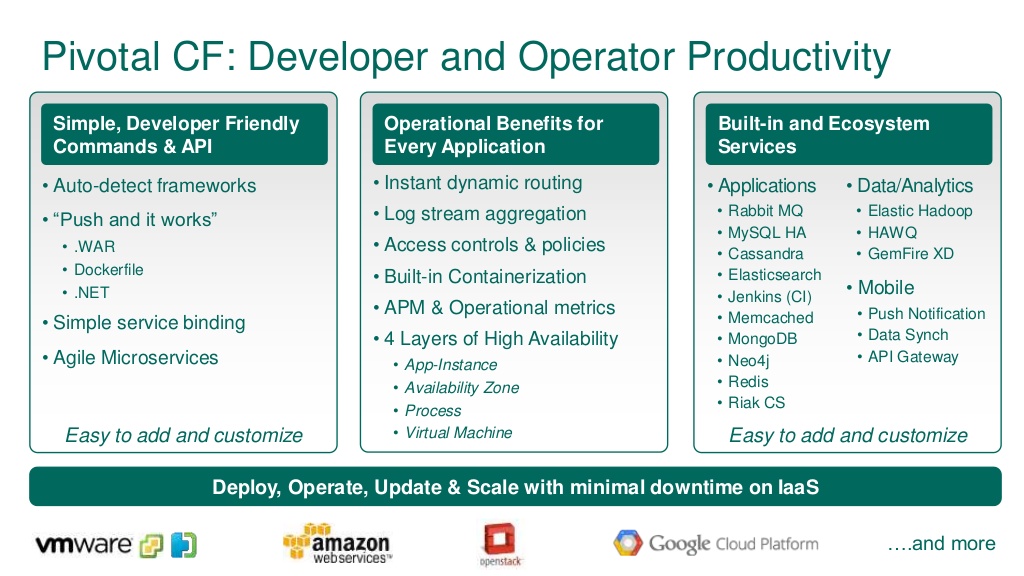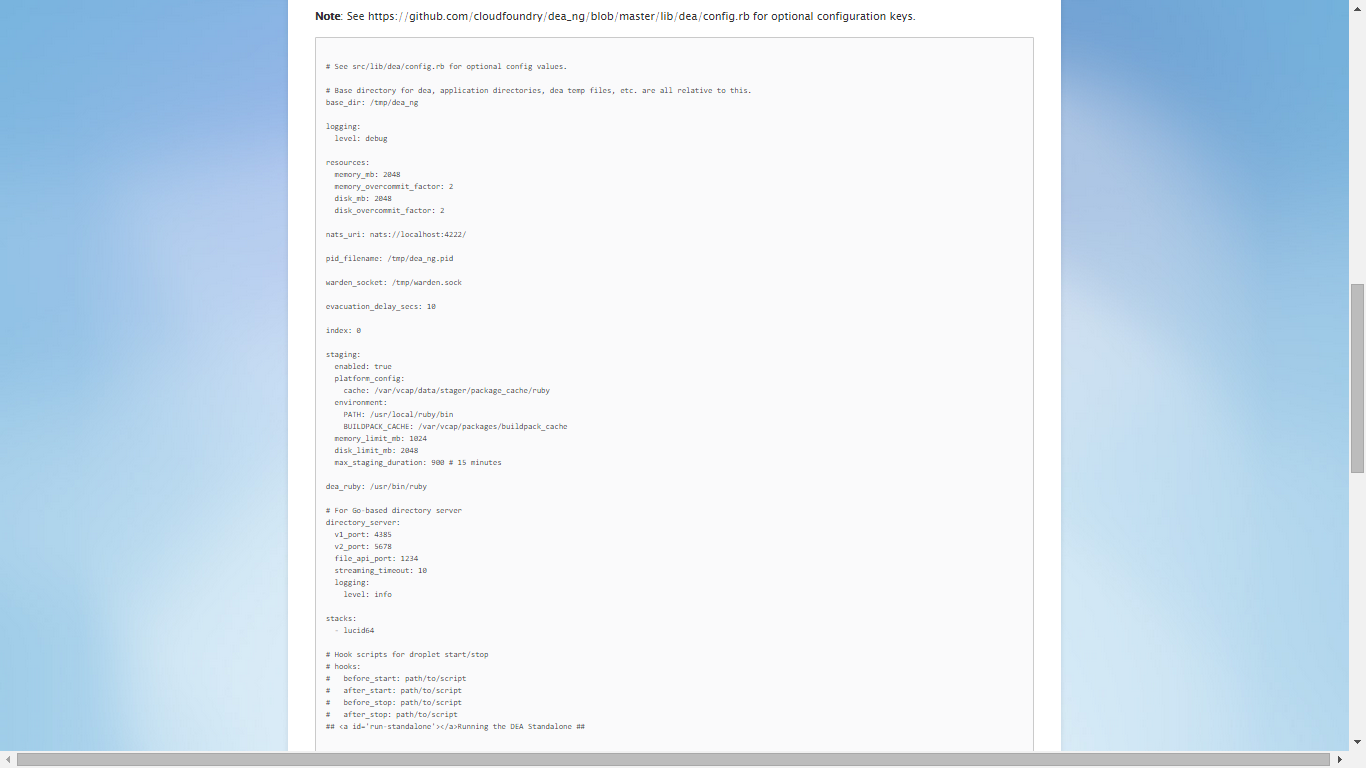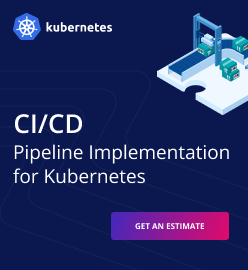Not Just for Developers, Pivotal Cloud Foundry for Ops: Four Levels of HA

Regardless of industry, Cloud Foundry increases developer productivity with dev-friendly commands and APIs, built-in services (DBs, CI, etc.), simple service binding, agile microservices, and ability to easily add new dev tools. Not limited to this, it also makes the life of operators much easier. For them, Cloud Foundry enables (or simplifies) instant dynamic routing, log stream aggregation, containerization, and HA. In this presenation, Cornelia explains how Pivotal CF (and Cloud Foundry) achieves four levels of high availability, increasing productivity of operators. Describing workflows, her slides demonstrate how Health Manager and Pivotal CF Operations Manager are involved in monitoring elastic runtime processes and VMs, replacing failed app instances and distributing them across availability zones.
Increasing developer’s and operator’s productivity
The emergence of a DevOps culture, being driven by the PaaS revolution and specifically by Cloud Foundry to some degree, can seem one-sided. DevOps is a joyful trend for developers, but disruptive for operations. Whereas developers love the idea of rapid (in their minds, instant) deployment and provisioning, the operations side needs to be encouraged to join the party.
Cornelia Davis, a Director of Platform Engineering at Pivotal, aims to bring operations to the party “by making their lives easier,” according to a presentation she made at VMworld 2014 and Cloud Foundry Summit 2014.
She outlined several areas in which the operations side benefits by using Pivotal CF, as shown in the middle column of this graphic from her presentation.

She also mentioned a number of built-in and ecosystem services—including RabbitMQ, MySQL HA, Cassandra, Jenkins CI, MongoDB, and Redis—as shown in the third column of the graphic.
The four layers of high availability
The crux of her argument was built around the notion of Four Layers of High Availability (HA). The layers involve the general areas of App Instance, Availability Zone, Process, and Virtual Machine.
The first two layers involve having apps instances, or more specifically, Droplet Execution Agents (DEAs) in two Availability Zones to keep instances available and running within the Pivotal CF Elastic Runtime subsystems (ERS).
Davis’s presentation was made around the time that Diego (DEAs in the Go language) was announced as a future consolidation and improvement. As of early 2015, Diego remained in Beta.
The second two layers involve the operations manager, and include process and virtual machine monitoring, recovery, and alterting. Slides 10-12 in the accompanying SlideShare illustrate this functionality. The big point to be made, it seems, is the self-healing nature of Pivotal CF, easing and simplifying the lives of operations.
Note: There is a very informative overview of DEAs at the Cloud Foundry community website, covering droplet execution, application staging, and the use of Warden containers, health checks, as well as the details of configuration and staging.

For more details about the ideas Cornelia described, check out her blog post on the topic.
The need to create a DevOps culture is the real deal. It is not just more business speak like "aligning business with IT," let alone egregious canards like "maintain competitive advantage" or "seamless interoperability."
Because if an organization cannot get its development and operations to commit to a loving relationship full of mutual respect and harmonious commitments, it may not enjoy all the value Cloud Foundry can provide.
This is going to be tough for a lot of companies to do; so read our architect’s guide to learn how to successfully adopt Cloud Foundry within an organization, overcome developer’s pushback, drive the DevOps culture to succeed, and much more.
Want details? Watch the video!
Table of contents
|
About the expert
 Cornelia Davis is Director of Platform Engineering on the Cloud Foundry Team at Pivotal. She is responsible for driving and executing customer and partner cloud platform strategies. Being a proficient platform engineer, Cornelia also willingly shares her knowledge at conferences, meetups, webinars, etc.
Cornelia Davis is Director of Platform Engineering on the Cloud Foundry Team at Pivotal. She is responsible for driving and executing customer and partner cloud platform strategies. Being a proficient platform engineer, Cornelia also willingly shares her knowledge at conferences, meetups, webinars, etc.









